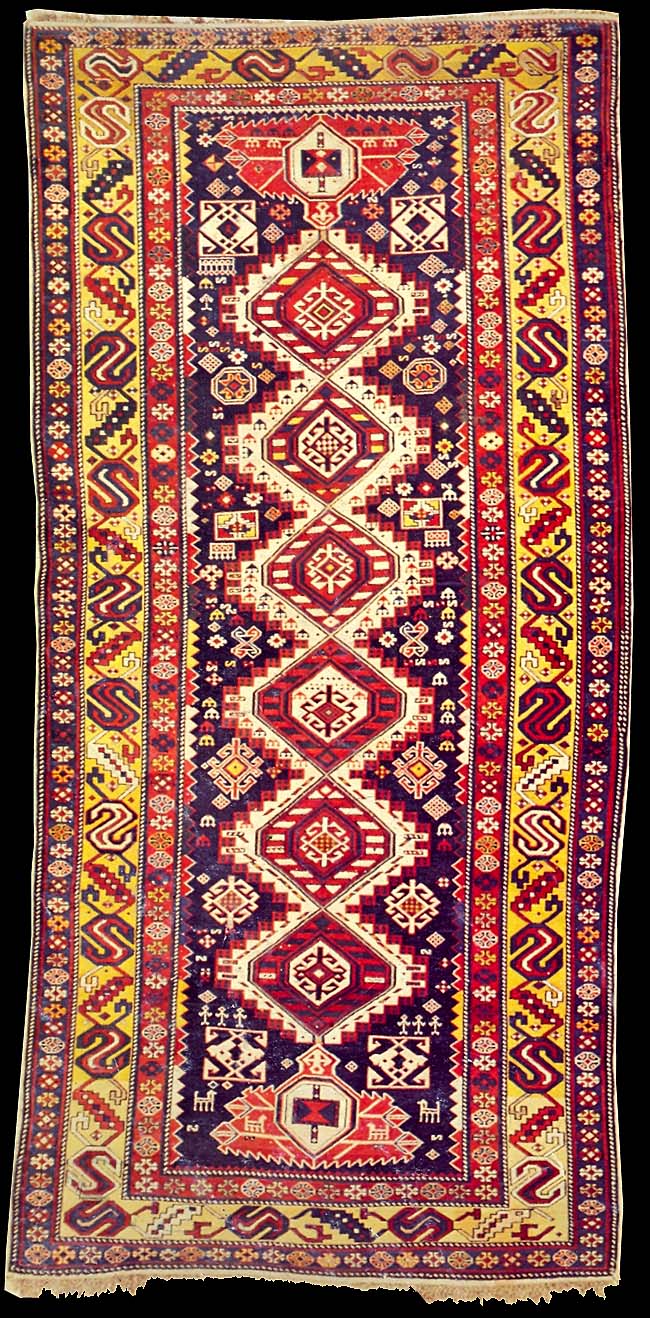|
256 This and the following five rugs represent a well known type of Shirvan
carpet composition which has rows of stepped edged and conjoined hexagonal
motifs arranged in a single vertical row, with a flattened, saw-edged
medallion at either end of the row; the latter motif has been related by
some authors to ancient Egyptian and Persian Royal insignia. On some
examples, such as that illustrated in Raymond Benardout's Caucasian Rugs
(p-51), large saw-edged medallions are found in a single vertical row, with
small hexagons at their centres. In general, these rugs, like the previously
described "flower Shirvans", are long and narrow. Usually they have all-wool
foundations and are slightly ribbed at the back, suggesting a provenance to
the northern part of the Shirvan area, an idea borne out by their
resemblance to so-called 'Zejwa' rugs from the area south of Kuba (compare
402-404). As with all generalisations about Caucasian weavings, however,
there are numerous exceptions—for instance the cotton-wefted piece with
white cotton overcast sides illustrated in Murray Eiland"s Oriental Rugs
(no. 159), the two examples with similar structure in Richard Purdon's,
Shirvan and related Weavings from the North Caucasus (nos 2 and 3), and the
cotton-wefted rug with blue cotton overcasting illustrated in Peter
Bausback's 1976 catalogue (p.89). These rugs almost all have dark blue
fields with myriad filler ornaments including animals, birds and human
figures; a yellow-ground border with linked 'S' motifs is commonly found—a
border which, both in colour and design is also found on north Persian
tribal and village rugs (cf. Jenny Houseso, Tribal Rugs, pl. 82). I know of
two published dated examples. The first is illustrated in the Australian
Society for Antique Rugs' 1974 catalogue, Antique Rugs from the Caucasus
(no. 13), with the date read as 1902, although I prefer the reading 1304
A.H. (A.D. 1886/7). The second dated example of this type came to light
recently in a provincial auction in England (Elliott and Green, Lymington,
28 June. 1979, lot 363); this had the typical field and 'interlock' border
composition, also similar-to our 261. was dated 1333 A.H. (A.D. 1914), and
was of very good quality apart from the albeit sparing use of synthetic
orange and pink. The present rug is very similar to examples in the
Metropolitan Museum (Dimand. no. 174) and in Schurmann's book (no. 66). A
very good piece, probably late 19th century. 252 x 118 cm
Lit: Ian Bennett's Oriental Rugs Volume I
published Ian Bennett's Oriental Rugs Volume I, plate 256
 |

